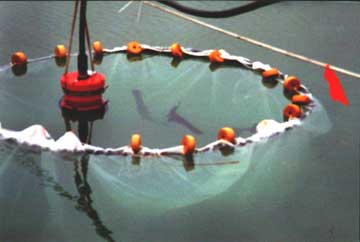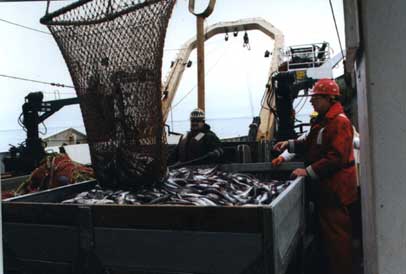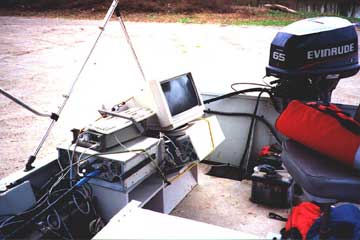
Data Acquisition Technology is Key to Sonar Detection of Fish Size and Species in Real Time

Figure 1: Field work setup to contain fish in a pond.
By Jerry Fireman
Scientific Fishery Systems Inc. (SciFish) has developed the first fish detection sonar system capable of identifying fish size and species in real-time. This system, called SciFish 2000, brings valuable new capabilities to the commercial industry including the ability to identify bottom fish and target only those that are profitable to catch. Preliminary tests of SciFish 2000 indicate that it is more than 85 percent accurate and its developers are working for 100 percent accuracy. The system is currently undergoing final testing and modification prior to its release as a commercial product. Key to the development of SciFish 2000 was a data acquisition processor (DAP), an analog-to-digital (A/D) converter with an onboard microprocessor, that permits the PC-based system to handle the massive amount of data generated by sonar transmissions. "If we had tried to use Windows for handling all this data, we wouldn't have gotten real-time readings," said Skip Denny, chief engineer of sonar systems at SciFish. "With the DAP, a PC becomes a viable platform for this demanding application."
Spectral Analysis of Broadband Sonar Identifies Fish
Broadband echoes contain more information [than narrowband sonar] because they encompass frequencies that provide greater backscatter within one fish species relative to others. ...Using spectral decomposition, it is possible to determine which frequencies are most strongly reflected by the fish targets. ...Each “ping” represents 100,000 data points. The system typically sends one ping per second.
“If we had tried to use Windows for handling all this data, we wouldn't have gotten real-time readings. With the DAP, a PC becomes a viable platform for this demanding application. ...It was a very simple operation to move the data using Microstar's built-in language.”
Skip Denny, Chief Sonar Engineer, Scientific Fishery Systems Inc. (SciFish)
Existing fishery sonar systems emit narrowband energy in one or two frequencies. They attempt to classify fish by characterizing their acoustic scattering by measuring the target strength of returned echoes. As such, available fish detection and classification systems work within the time-domain of the signal and focus on the integration of sonar returns (energy) over a given volume of water. Fish detection and classification systems of this type are labor-intensive to build, they require specialized training for operation, their narrowband frequencies are not adequate for all species, and their accuracy and robustness depends on a significant amount of operator training. As a result, they are able to identify fish to species only when large numbers of fish are available over long periods of time or their sizes are sufficiently different.
SciFish 2000 is designed to overcome these limitations. The system is the product of SciFish, an Anchorage, Alaska-based company working to develop technologies and products for more efficient fisheries. SciFish 2000 is based on research done by the Anti-Submarine Warfare (ASW) sector of the defense community that demonstrates that sonar is more effectively processed in the frequency domain, which is only possible using broadband sonar. SciFish's founders had previously assisted in the development of several ASW systems for tactical, strategic and surveillance missions within the Navy and ARPA. SciFish 2000 represents the first effort toward converting these defense techniques to fisheries. In addition to identifying fish in real- time, it brings some important new capabilities to the fishing industry such as bottom fish detection, bottom type classification, and fish length estimation. The company believes the product will be useful in three sectors of the fishing industry. First, commercial fisheries can use the product to target only the species they wish to catch, improving the efficiency of their operations. Second, the product provides fisheries managers with an improved tool for fish stock and resource assessment. Third, the system will allow fisheries biologists to collect and process their own data.
|
|
Technology Basis
SciFish combines three underlying technologies to make real-time identification possible. One is broadband sonar transmission. Broadband echoes contain more information because they encompass frequencies that provide greater backscatter within one fish species relative to others. The SciFish 2000 digitally processes the broadband echoes to produce frequency spectra. Spectral processing, the second underlying technology, provides a rich representation not available to existing fish finding sonar systems that use only time-domain processing that counts and integrates echoes. Using spectral decomposition, it is possible to determine which frequencies are most strongly reflected by the fish targets. The spectral information is presented to a fuzzy neural network classifier, the third underlying technology, for identification. Signatures of fish (fuzzy neural network coefficients) are created by the user for those species of interest. These signatures are stored in a database where they are later recalled for classification. The system is built around a Pentium III PC running Windows NT. The spectral processing and fish identification applications are Windows-based for ease of use.
These technologies require the processing of huge amounts of data. A broadband sonar transceiver generates analog echoes, amplifies the echoes, tunes the echoes for the frequency response of the transducer, and transmits the resulting echo from the transducer. Each "ping" represents 100,000 data points. The system typically sends one ping per second. The transducer collects the analog echo returns, applies amplification with adjustable gain to the echoes, and bandpass filters the echoes. The transducer must pass the echoes to an A/D converter capable of sampling at 769k samples per second to satisfy the Nyquist sampling criteria and to achieve sufficient amplitude range and resolution. In addition to collecting all this data, the system must simultaneously process the information. After the data leaves the A/D converter, the PC performs a number of complicated data analysis steps, including producing digital echoes, to determine whether the sonar pulse has bounced off an object and returned, performing feature extraction to measure specific characteristics of the echo to create the signature for the fish, and using the feature information in the fuzzy neural network to classify the fish.
One of the options for simultaneously handling this large amount of data acquisition and processing was to use separate systems for each task: a dedicated data acquisition device for data collection and the PC for running the data analysis applications. This would have driven up the size and the cost of the SciFish 2000. The company wanted to avoid that, but in trying to use a PC to handle both processes, they ran into another problem-the fact that Windows is not a real-time operating system. "We needed to find a way to move data through the system without involving the Windows or the PC's CPU," explained Denny. "To move this much data around in real time, computing power has to be available when it is needed, every microsecond or so. Operating systems like Windows use up many cycles on the PC platform, and when they take control of the CPU, they hold onto it for a long time in machine control terms." If data transfer functions were to run under Windows, the system would be vulnerable to a situation where Windows was occupied with other tasks, possibly interrupting the data flow.
|
|
The solution was to use a DAP board for the PC platform from Microstar Laboratories. The unique capability offered by DAPs is an onboard microprocessor that runs a multitasking, real-time operating system optimized for high-performance data acquisition and control applications. The intelligence on the DAP board extends the power of the Windows user interface by executing all processor-intensive routines in real-time so that the software on the PC can handle more demanding applications than usual. There is never any danger of losing data, regardless of how many computer cycles are dedicated to the foreground application or even if Windows crashes. The data acquisition processor continues to run the special routine that collects data from the acquisition devices totally independent of the central processor.
Denny configured the SciFish 2000 with the Microstar DAP 3200a, which was designed for applications where there is a need for real-time processing of data in the time interval between samples and for applications such as his that require fast sampling rates. The DAP 3200a has an onboard Intel processor and four megabytes of DRAM. It samples analog inputs at up to 769k samples per second and transfers data to the PC at rates of up to 909,000 samples per second. Denny used commands built into DAPL, the DAP 3200a's onboard operating system, to write the control programs that move the data from the DAP to the PC. DAPL provides more than 100 commands optimized for data acquisition and machine control. "It was a very simple operation to move the data using Microstar's built-in language," Denny said.
SciFish 2000 has been tested in the Great Lakes and in Prince William Sound with a commercial fisherman, and in the Missouri River with research biologists. In these tests, SciFish 2000 has demonstrated that it provides superior discrimination of targets at or near the bottom, and better than 80% correct species identification on more than 20 species of fish. In some instances, the identification performance exceeds 95% correct. The DAP board has held up well in the rugged marine environment, Denny noted, and has performed flawlessly in all tests to date. The SciFish 2000 is currently undergoing a final round of testing in the Bering Sea and New England prior to its official release as a commercial product.
Jerry Fireman is founder and president of Structured Information (Birmingham, MI). He may be contacted at editor@scimag.com.
Reproduced with permission from Scientific Computing.
Browse other customer applications.


